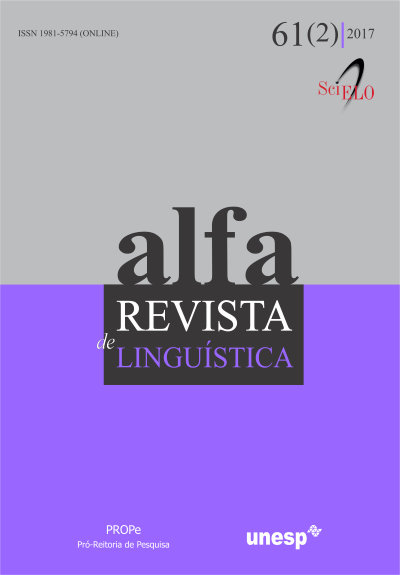The Linguistic Atlas of Amapa Project (ALAP): pathways and current stage
DOI:
https://doi.org/10.1590/1981-5794-1709-3Keywords:
Dialectology, Geolinguistic, Atlas, Amapa,Abstract
The field of dialectology, focusing on geolinguistic method has grown a lot in Brazil, and this is represented in all states of the federation and a very significant projection. In this context fits the Project Linguistic Atlas of Amapa (ALAP). The main objective of this article is to show the trajectory of ALAP Project and its first results. The Project adopted the geolinguistic method (CARDOSO, 2010) and was developed from three stages: 1) formation and training of members of the research group; 2) experimental investigations were carried out, training for phonetic transcription, the implementation of on-site research (application of questionnaires phonetic-phonological and lexical-semantic), with the location of 40 informants distributed in 10 points surveys; 3) review of phonetic transcriptions, the making of the letters and the mapping of the data recorded, with a view to systematization, organization and publication of results. Currently, the ALAP Project seeks financial support for publication, which will feature about 100 linguistic chart dealt in phonetics and lexical.Downloads
Download data is not yet available.
Downloads
Published
01/09/2017
How to Cite
RAZKY, A.; RIBEIRO, C.; SANCHES, R. The Linguistic Atlas of Amapa Project (ALAP): pathways and current stage. ALFA: Revista de Linguística, São Paulo, v. 61, n. 2, 2017. DOI: 10.1590/1981-5794-1709-3. Disponível em: https://periodicos.fclar.unesp.br/alfa/article/view/8643. Acesso em: 31 dec. 2025.
Issue
Section
Papers
License
Manuscripts accepted for publication and published are property of Alfa: Revista de Linguística. It is forbidden the full or partial submission of the manuscript to any other journal. Authors are solely responsible for the article's content. Translation into another language without written permission from the Editor advised by the Editorial Board is prohibited.

